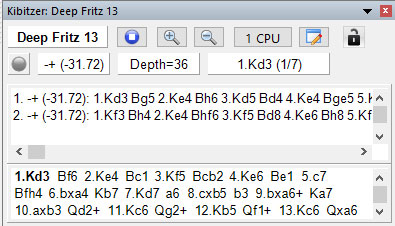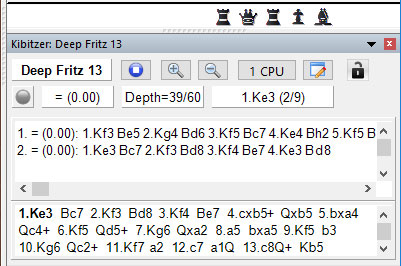The story was broken by Sarah Knapton, Science Editor of The Telegraph, who put it up in her newspaper. In it she reported on the launch of the new Penrose Institute, founded by mathematics professor Sir Roger Penrose, who gained world-wide renown in 1988 by working out black hole singularities together with Stephen Hawking (the two received the Wolf Prize in Physics for that). I was unable to find the original chess artical on the Penrose Institute site, but Sarah Knapton quotes extensively from it:
The chess problem – originally drawn by Sir Roger – has been devised to defeat an artificially intelligent (AI) computer but be solvable for humans. The Penrose Institute scientists are inviting readers to work out how White can win, or force a stalemate, and then share their reasoning. The team then hopes to scan the brains of people with the quickest times, or interesting Eureka moments, to see if the genesis of human ‘insight’ or ‘intuition’ can be spotted in mind.
Can you solve the puzzle?
Scientists from the Penrose Institute want to hear from you if you've cracked it. They write:
The puzzle above may seem hopeless for White, with just a king and four pawns remaining, but it is possible to draw and even win. Scientists have constructed it in a way to confound a chess computer, which would normally consider that it is a win for Black. However an average chess-playing human should be able to see that a draw is possible.
A chess computer struggles because it looks like an impossible position, even though it is perfectly legal. The three bishops forces the computer to perform a massive search of possible positions that will rapidly expand to something that exceeds all the computational power on planet earth.
Humans attempting the problem are advised to find some peace and quiet and notice how the solution arises. Was there a flash of insight? Did you need to leave the puzzle for a while and come back to it? The main goal is to force a draw, although it is even possible to trick black into a blunder that might allow white to win.
The first person who can demonstrate the solution legally will receive a bonus prize. Both humans, computers and even quantum computers are invited to play the game and solutions should be emailed to puzzles@penroseinstitute.com.

Read the full Telegraph article here
The Telegraph report was picked up by a number of media outlets, like this one (in Mashable). There Lance Ulanoff writes:
It’s hard to imagine how the game got here—it's even harder to imagine what happens next, let alone a scenario in which four white pawns and a white king could play to a draw, or even win this game. Yet: scientists at the newly-formed Penrose Institute say it’s not only possible, but that human players see the solution almost instantly, while chess computers consistently fail to find the right move.
“We plugged it into Fritz, the standard practice computer for chess players, which did three-quarters of a billion calculations, 20 moves ahead," explained James Tagg Co-Founder and Director of the Penrose Institute, which was founded this week to understand human consciousness through physics. "It says that one side or the other wins. But," Tagg continued, "the answer that it gives is wrong."

True. Above is the calculation displayed by the oldest engine I have installed on my notebook. Fritz 13 scores the position as 31.72 pawns ahead for Black. On ChessBase India Sagar Shah checked it out with Houdini 5.01 Pro 64 bit, down to 34 ply in a four-line search. Result: 24.91 pawns ahead for Black.
It is true that chess engines will display high scores in favour of Black, due to the material advantage of a queen, two rooks, three bishops and a pawn. What they are saying is that Black has a huge material advantage, one that should result in a win (–+). And they will keep moving their bishops, displaying a high positive evaluation right until the 50-move rule approaches and they see there is no possibility of forcing a pawn move by White. Maybe some of our readers can play out the position and tell us when top engines see the futility of continuing to move and display an eval = 0.00.

Interestingly, when I remove two black bishops my ancient Fritz 13 sees the draw in mere seconds. If I remove just one bishop it does not come up with a 0.00 evaluation in a reasonable amount of time.
But now we come to the humans, who can indeed work things out in a flash: the position is extremely contrived, and so the first thing you do is work out that Black has no legal moves except with his bishops. All White needs to do to defend the position is not to capture a black rook and not move the c6-pawn. He simply moves his king around, mainly on the white squares, and lets Black make pointless bishop moves. Absolutely nothing can go wrong. Once again we ask the owner of very old chess engines to check whether any of them will capture a rook, in order to reduce the material disadvantage slightly – but in the process lose the game.
On the other hand the contention that "it is even possible to trick Black into a blunder that might allow White to win" seems extremely far-fetched. Black would need to move his bishops out of the way, while White advances his king to protect the c-pawn, which then promotes (e.g. 1.Kf3 Be1 2.Ke4 Bc1 3.Kd5 Ba1 4.Ke6 Bec3 5.c7 Kb7 6.Kd7 Bf4 7.c8=Q#), but that is not White tricking Black, it is some kind of pointless helpmate.
Anyway, it is trivially easy for White to hold the draw, and the Penrose Institute will probably receive hundreds of correct solutions submitted by average chess players. The scientists say they are interested in the thought process that lead people to the solution – a sudden moment of genius, or the result of days of consternation? "If we find out how humans differ from computers, then it could have profound sociological implications," Penrose told The Telegraph. Really?
There are much more elegant positions and more profound examples that show the difference between human and computer thinking. Back in March 1992 I published the following study in a computer magazine, as a challenge for any machine to get it right:

[Event "La Strategie / CSS 3/92-29"] [Site "?"] [Date "1912.??.??"] [Round "?"] [White "Rudolph, W."] [Black "White to play and draw"] [Result "1/2-1/2"] [SetUp "1"] [FEN "3B4/1r2p3/r2p1p2/bkp1P1p1/1p1P1PPp/p1P1K2P/PPB5/8 w - - 0 1"] [PlyCount "11"] [EventDate "1912.??.??"] 1. Ba4+ $1 Kxa4 (1... Kc4 2. Bb3+ Kb5 3. Ba4+ Kc4 $11) 2. b3+ Kb5 3. c4+ Kc6 4. d5+ Kd7 5. e6+ Kxd8 6. f5 1/2-1/2
|

You probably know that you can switch on an engine on our JavaScript board (and move pieces to analyse). You can maximize the replayer, auto-play, flip the board and even change the piece style in the bar below the board. At the bottom of the notation window on the right there are buttons for editing (delete, promote, cut lines, unannotate, undo, redo) save, play out the position against Fritz. Hovering the mouse over any button will show you its function. |
Fritz & co. display an eight-pawn disadvantage for White. The correct first move is to sacrifice even more material, which is the only way to secure a draw. This is a much more relevant test, as chess engines, playing the white side, will actually select the wrong strategy and lose the game. In the Penrose position computers think that White is losing, but they will hold the draw without any problem (I say this without having tested older engines and trying to entice them into capturing a rook and losing the game).
This little recreational pastime of taking the mickey out of chess playing computers has a long history, which will be told at a later stage. I must admit: it is getting harder and harder as these things get stronger and stronger.




























